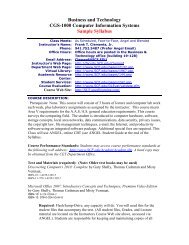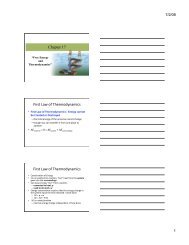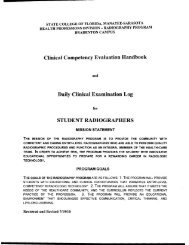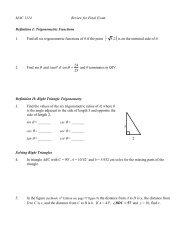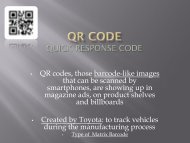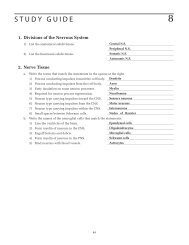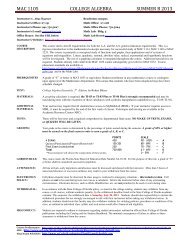Chapter 22 Notes 3 slides to a page - Scf
Chapter 22 Notes 3 slides to a page - Scf
Chapter 22 Notes 3 slides to a page - Scf
- TAGS
- slides
- faculty.scf.edu
Create successful ePaper yourself
Turn your PDF publications into a flip-book with our unique Google optimized e-Paper software.
Proteins <br />
Proteins <br />
• The most important of all biological <br />
compounds <br />
<strong>Chapter</strong> <strong>22</strong> <br />
• Derived from proteios meaning “of first <br />
importance” <br />
FuncBons of Proteins <br />
• Structure: collagen and keraBn <br />
• Catalysis: enzymes <br />
• Movement: muscle <br />
• Transport: hemoglobin <br />
• Hormones: insulin, human growth hormone, etc <br />
• ProtecBon: anBbodies <br />
• S<strong>to</strong>rage: casein in milk, ovalbumin in eggs <br />
• RegulaBon: control gene expression and dictate <br />
manufacturing of protein <br />
11/2/09 <br />
1
ClassificaBon of Protein <br />
• Two major classes: <br />
– Fibrous: mainly insoluble in water <br />
– Globular: more or less soluble in water <br />
Amino Acids <br />
• All proteins are composed of small subunits <br />
called amino acids <br />
• An amino acid has a carboxyl group group on <br />
one end and an amino group on the other <br />
• There are 20 common naturally occur amino <br />
acid <br />
Amino Acids <br />
Amino acids can be <br />
broken in<strong>to</strong> 4 <br />
classificaBon: <br />
Non‐polar <br />
Polar, uncharged <br />
Acidic <br />
Basic <br />
11/2/09 <br />
2
Amino Acids <br />
Amino acids can be <br />
broken in<strong>to</strong> 4 <br />
classificaBon: <br />
Non‐polar <br />
Polar, uncharged <br />
Acidic <br />
Basic <br />
ZwiWerions <br />
• Amino acid have an acid and a <br />
base end <br />
• The acid and base cannot co‐<br />
exist in water <br />
• So the acid end donate a <br />
pro<strong>to</strong>n <strong>to</strong> the base end <strong>to</strong> form <br />
a zwiWerion <br />
Some Uncommon Amino Acids <br />
11/2/09 <br />
3
Amino Acids Forming Proteins <br />
• A carboxylic acid can react with an amine <strong>to</strong> <br />
form a amide bond <br />
• A amide bond is what is formed between <br />
amino acids <br />
• A amide bond in protein is called a pepBde <br />
bond or pepBde linkage <br />
• If two amino acid join you get a dipeBde <br />
Aspartame <br />
• This is the dipepBde of a asparBc acid and <br />
phenylalanine <br />
• This dipepBde is about 200 Bmes sweeter <br />
than sugar <br />
ProperBes of Proteins <br />
• ProperBes are based on the pepBde backbone <br />
and the side chains <br />
• The pepBde bond is almost planar <br />
11/2/09 <br />
4
AGE and Aging <br />
Protein Structure: Primary <br />
• The primary structure is the sequence of the <br />
amino acids that make up the chain <br />
• Many different possibility <br />
– DipepBdes: 20 x 20 = 400 possible <br />
– TripepBdes: 20 x 20 x 20 = 8000 possible <br />
– 20n where n is the length of the protein <br />
– If a small protein had only 100 amino acid then <br />
20 100 = 1.27 x 10 130 <br />
The Use of Human Insulin <br />
11/2/09 <br />
5
Sickle Cell Anemia <br />
Protein Structure: Secondary <br />
• Protein fold <strong>to</strong> align themselves in such a <br />
manner that certain paWerns repeat <br />
• The repeaBng paWerns are called the <br />
secondary structure <br />
• There are two main secondary structures <br />
• These secondary structure are mainly held in <br />
place by hydrogen bonding <br />
Protein Structure: Secondary <br />
11/2/09 <br />
6
Protein Structure: TerBary <br />
• The terBary structure of a protein is the three <br />
dimensional arrangement of every a<strong>to</strong>m in the <br />
molecule <br />
• The terBary structure is produce and stablized <br />
by pepBde backbone interacBon and side <br />
chain interacBon <br />
Five Stabilizing Fac<strong>to</strong>rs <br />
• Covalent bonding: Disulfide linkage between <br />
cysteine residues <br />
• Hydrogen Bonding: from a N‐H or O‐H <br />
• Salt Bridges: between a acid and a base side <br />
chain <br />
• Hydrophobic InteracBon: water pushed non‐<br />
polar area <strong>to</strong>gether <br />
• Metal Ion CoordinaBon: two negaBve side <br />
chains link <strong>to</strong>gether by aWracBon <strong>to</strong> a + ion <br />
Noncovalent InteracBon <br />
11/2/09 <br />
7
Example of Stabilizing Forces <br />
Protein Structure: Quaternary <br />
• The highest level of protein structure <br />
• It is not found in all protein <br />
• It involves the linking of subunits <br />
• Very large proteins <br />
Example of Quaternary Proteins <br />
• Hemoglobin <br />
– Made up of 4 subunits <br />
– Two idenBcal alpha chains and <br />
two idenBcal beta chains <br />
– Each globin chain surrounds an <br />
iron containing heme unit <br />
– The non‐amino acid porBon of <br />
the protein is called a prostheBc <br />
group <br />
11/2/09 <br />
8
Example of Quaternary Proteins <br />
• Collagen <br />
– A triple helix units called <br />
tropocollagen consBtute the soluble <br />
form of collagen <br />
– Collagen consists of many <br />
troprocollagen units <br />
– Troprocollagen is found in fetal Bssue <br />
and young connecBve Bssue <br />
– With aging, the triple helixes <br />
crosslink and form insoluble collagen <br />
Example of Quaternary Proteins <br />
• Integral Membrane <br />
Protein <br />
– These proteins traverse <br />
partly or completely a <br />
membrane bilayer <br />
11/2/09 <br />
9





